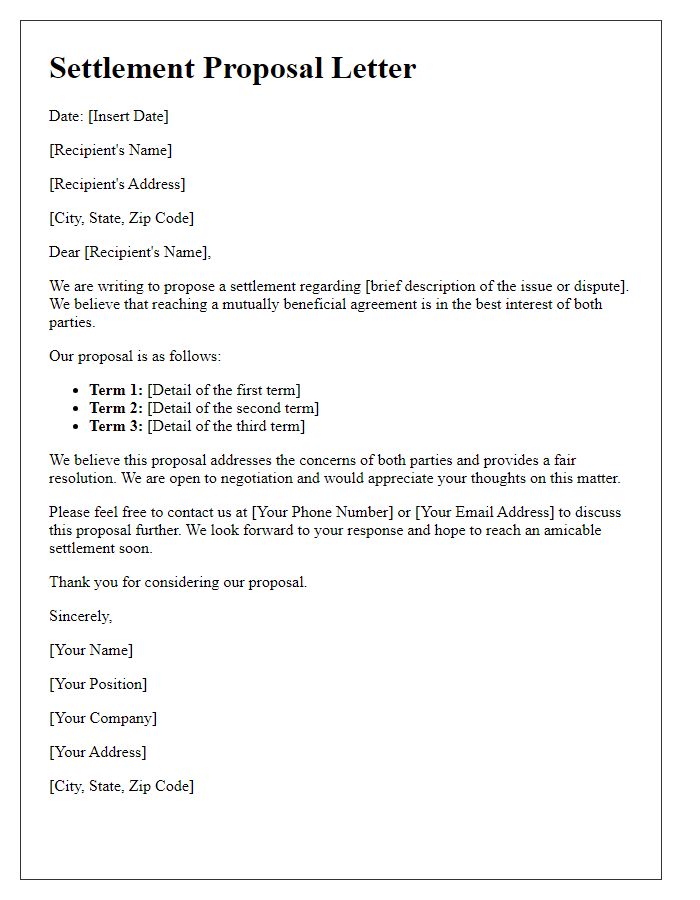Are you navigating the often complex waters of a settlement proposal? Crafting the right letter can make all the difference in reaching a favorable agreement. In this article, we'll explore effective templates and strategies that can help you communicate your intentions clearly and persuasively. So, let's dive in and discover how to present your settlement proposal with confidence!

Clear Intent Statement
Settlement proposals often involve clear intent statements to convey the purpose and motivation behind the negotiation process. This statement outlines the desire to reach a mutually agreeable resolution while emphasizing the importance of effective communication. For instance, in a legal dispute involving contract breaches, the intent may focus on avoiding lengthy litigation processes and fostering cooperative dialogue. Clarity in intention not only aids in establishing trust between parties but also sets a constructive tone, enhancing the likelihood of reaching a settlement. This approach can be particularly beneficial in high-stakes environments, such as corporate negotiations in New York City, where two companies aim to settle financial disagreements amicably. By articulating a clear and concise intent statement, parties can navigate complex discussions with a focus on solutions rather than conflict.
Comprehensive Offer Details
A comprehensive settlement proposal typically includes detailed information regarding the terms of the agreement and the parties involved. This includes specific compensation amounts, such as a total of $50,000, which may cover damages and legal fees incurred during the dispute process. Additionally, clauses might address non-disclosure agreements to maintain confidentiality regarding the proceedings. Important dates, such as the deadline for acceptance or any stipulations regarding payment timelines, should also be outlined clearly. Essential parties, including legal representatives and corporate stakeholders, must be identified by name and role to ensure transparency and accountability in the agreement process. Moreover, proposed timelines for compliance and future communication protocols may be included to facilitate ongoing negotiations or resolutions.
Legal and Financial Terms
The settlement proposal communications in legal disputes often outline financial terms, obligations of the parties, and timelines for compliance. A settlement amount, such as $150,000, may be proposed to resolve claims without litigation. Confidentiality clauses ensure both parties agree not to disclose the terms, protecting sensitive information. Payment schedules, including deposits, installments, or lump sums, are crucial in establishing clear expectations for financial transactions. Additionally, the proposal may incorporate liability releases, preventing future claims related to the current dispute. Deadlines for acceptance of the proposal, often ranging from 10 to 30 days, are essential to promote prompt resolutions and avoid prolonged negotiations. Legal counsel's review is advisable to ensure compliance with applicable laws and regulations.
Deadline for Response
Settlement proposals often involve intricate negotiations and timeliness is crucial. A settlement proposal may outline a specific deadline for response, typically ranging from five to fifteen business days from the date of receipt. This deadline allows both parties, whether individuals or corporate entities, to assess the terms thoroughly, consult legal counsel, and prepare counter-offers if necessary. Clear communication about the deadline is essential to ensure that all parties remain aware of their responsibilities and to avoid misunderstandings. Failure to respond by the set deadline could potentially result in withdrawal of the proposal or escalation of the dispute, leading to legal proceedings in a court, potentially in a jurisdiction such as New York or California, known for their distinct legal frameworks regarding contract disputes.
Formal and Polite Tone
The concept of a settlement proposal in legal communications involves a structured approach addressing dispute resolution. In civil litigation contexts, parties often present settlement proposals to avoid lengthy court proceedings. A well-crafted settlement proposal usually includes a brief introduction outlining the purpose, the that is party aggrieved, a detailed presentation of the facts from both perspectives, proposed settlement terms, a rationale for the proposal supported by evidence, and an invitation for dialogue to reach a resolution. The tone should convey respect and a willingness to cooperate, while maintaining clear and formal language to uphold professionalism in the context of potentially sensitive negotiations.













Comments